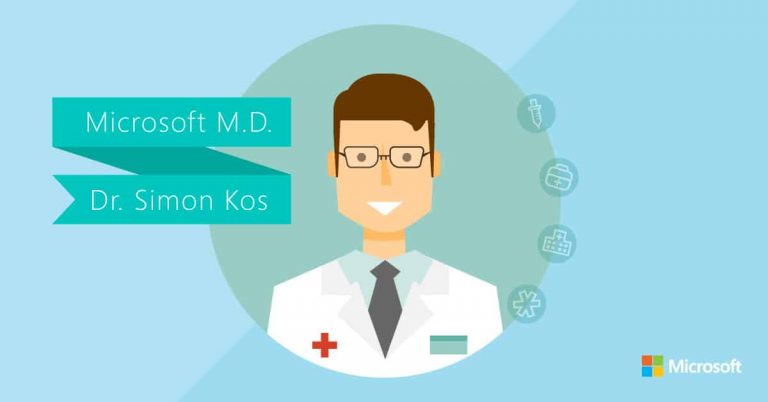As a company aiming to empower everyone to achieve more, health IT has been an important focus for Microsoft over the last few years. The company efforts go well beyond the Microsoft Band 2 and the Microsoft Health platform as the company has been constantly working to find use cases in the health industry for its technologies such as its cloud, the Kinect or even the HoloLens.
As an example, we reported earlier this year that global healthcare company Novartis was experimenting with the Kinect to help doctors assess multiple sclerosis, and earlier in 2015 the Redmond giant has also partnered with John Hopkins University to scale up new healthcare solutions leveraging the company’s cloud technologies.
In January, Bill Crounse, MD and Senior Director, Worldwide Health at Microsoft announced his retirement after nearly 14 years at the company. The former Chief Medical Officer had created the company’s HealthBlog in 2005, writing more than 800 articles about digital tech in health and healthcare over 10 years, and he also used his television experience to develop the on-line video series Health Tech Today on YouTube.
It took a few months for Microsoft to find his replacement, but the company announced in a blog post yesterday that it has chosen Dr. Simon Kos as its new Chief Medical Officer. While Kos was already the doctor in Microsoft’s health team, he did not forget to acknowledge the accomplishments from his predecessor
As I take over the mantle of being the Microsoft MD from Dr. Bill Crounse, I’m proud and humbled. Dr. Bill made an incredible impact during his tenure as the clinical leader for the Microsoft Health team. His are big scrubs to fill, but luckily I have the help of the incredibly talented and hard-working Microsoft Health team. We all share the same drive to support health organizations’ goals to empower better health through digital transformation.
As Microsoft’s new Chief Medical Officer, Kos will be responsible for providing clinical guidance, worldwide thought leadership, vision and strategy for Microsoft technologies and solutions in the health and healthcare industries. You can learn more about Kos’ background below.
His background as a practicing doctor
“What I loved about being a doctor was being able to make a difference in people’s lives,” explained Kos, who describes himself as a medical doctor with a passion for improving healthcare through information technology. As he explains, his passion for health IT is actually a result from is past experiences as a practicing doctor in the emergency room, as he during this time he came to realize that improving care team communications could lower the risk of medical of medical errors:
Working a 30-plus hour shift in the emergency room (ER) as a first-year resident, I told my supervisor that I was worried I’d make a mistake and harm a patient given how tired I was. His response: “Get over yourself. We all harm people during our career because of errors. You’ll just help more people than we harm.”
Healthcare is an information industry, and the technologies we were using to manage information and coordinate care were less than satisfactory. It became clear to me that we needed to improve our systems in healthcare. Patients need health professionals looking after them who are empowered to do their best work. And to do that, we must look after the systems that health professionals use. Health IT needs to not only help prevent medical errors, but also promote a proactive, preventive approach to health.
How he switched to a career in Health IT
After working a few years as a Medical Officer in Sidney, Australia, Kos decided to go back to school to study software engineering. He then worked with global health IT companies InterSystems and Cerner and helped them to implement e-Health initiatives in Australia. He joined Microsoft in 2010 as a Health Industry Manager “with the appreciation that improving health and healthcare was about more than just putting in EMRs.” He added:
As the doctor on Microsoft’s health team, I was responsible for engagement of the clinical community. I raised awareness of the Microsoft brand, technology and partner community, and worked to find clinical relevance for Microsoft products. I served as a clinical advisor to the talented internal team.

Why he thinks health IT can make a difference in people’s lives
Kos thinks that health IT can “make a difference in people’s lives at a system-wide level” and believes that Microsoft can help health organizations understand how they can leverage modern technologies to enable a healthier future:
Health organizations need to surround their EMR with technologies that help them connect information, people, and processes across the care continuum. They require solutions that can help them engage patients, empower care teams, optimize clinical and operational effectiveness, and transform the care continuum.
Today’s technologies can empower entirely new ways of doing things. They can help enable the shift from a hospital-based system to a community-based system. They can help identify people who need care before they land in the hospital. They can help get people home from the hospital sooner. And they can help scale metropolitan clinical resources to areas of need. These and many more ways to improve people’s care and well-being are possible today with technologies such as cloud services, the Internet of Things, predictive intelligence, and video conferencing—to name just a few.
Microsoft continues to emphasize health and health IT, and it’s good to see a new Chief Medical Officer in place.


